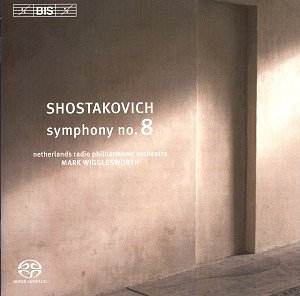Not often do we find
a conductor annotating his own recordings,
yet here is Wigglesworth providing the
booklet notes too ... and very informative
they are too. He clearly has something
to say in sonic terms as well, for this
is an account of the Eighth that is
certainly individual.
The Netherlands Radio
Symphony Orchestra is an excellent ensemble,
although a certain lack of tonal body
to the violins suggests that it is perhaps
not absolutely first class. This manifests
itself most strongly in a certain carefulness
on the part of the players and this
in turn points towards a lack of saturation
in the music. And the most important
ramification of this is that the sheer
terror that resides in this work's strongest
climaxes is missing.
Thus the imposing beginning
reveals the low strings' tonal heft
but also the violins' shortcomings.
And for proof of short-changed climaxing,
try the big moment of the first movement
- around nineteen minutes in. It is
impressive - especially in a recording
as spacious, powerful and detailed as
this one - yet it is emphatically not
bone-chilling. The post-cataclysm cor
anglais (Miriam Hannecart) sings her
baleful song most effectively, however.
Better is the first
of the work's two scherzos; very determined
and possessed of great brass definition.
A pity the very end is very careful,
very microphone-aware. The second Scherzo
could have been even more relentless.
The crescendi could never be called
frightening, although the final one
does lead very effectively into the
austerity of the Largo. The real pianissimi
of this latter movement may force you
to listen - wonderful control by the
Rotterdam strings here as they convey
impressive, disturbing stasis.
The bassoon that opens
the finale is like a shaft of light,
while the macabre dance around 3'40
- its nature may perhaps be best described
as bizarre-sleek - is very well done
indeed. The same can be said of the
leader's contributions later on – all
credit to Joris van Rijn.
There is much to admire
here. Wigglesworth is a fast-maturing
conductor and it is good that we have
this opportunity to track his career.
The Netherlanders respond well and with
devotion to his direction, and the sound
secured by Bis is beyond reproach.
This is in no terms
a first recommendation, true, but it
represents a fascinating seventy minutes
worth of listening.
Colin Clarke


